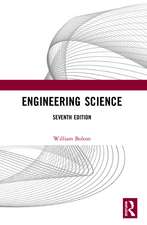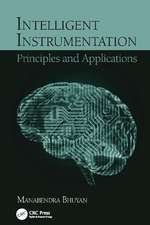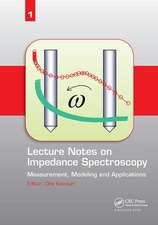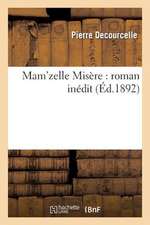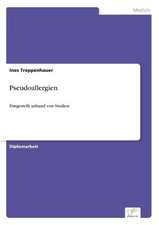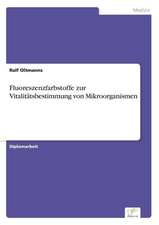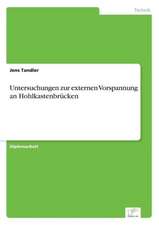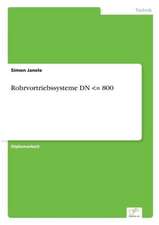Smart CMOS Image Sensors and Applications: Optical Science and Engineering
Autor Jun Ohtaen Limba Engleză Hardback – 4 iun 2020
Features
• Covers the fundamentals and applications including smart materials, smart imaging, and various applications
• Includes comprehensive references
• Discusses a wide variety of applications of smart CMOS image sensors including biotechnology and optical wireless communication
• Revised and expanded to include the state of the art of smart image sensors
| Toate formatele și edițiile | Preț | Express |
|---|---|---|
| Paperback (1) | 314.87 lei 43-57 zile | |
| CRC Press – 2 oct 2023 | 314.87 lei 43-57 zile | |
| Hardback (1) | 891.36 lei 43-57 zile | |
| CRC Press – 4 iun 2020 | 891.36 lei 43-57 zile |
Din seria Optical Science and Engineering
- 23%
 Preț: 351.77 lei
Preț: 351.77 lei - 18%
 Preț: 2071.64 lei
Preț: 2071.64 lei - 18%
 Preț: 1390.92 lei
Preț: 1390.92 lei - 15%
 Preț: 489.26 lei
Preț: 489.26 lei - 15%
 Preț: 502.76 lei
Preț: 502.76 lei - 22%
 Preț: 352.95 lei
Preț: 352.95 lei - 15%
 Preț: 597.90 lei
Preț: 597.90 lei - 18%
 Preț: 840.06 lei
Preț: 840.06 lei - 18%
 Preț: 1564.72 lei
Preț: 1564.72 lei - 18%
 Preț: 1938.64 lei
Preț: 1938.64 lei - 18%
 Preț: 1345.30 lei
Preț: 1345.30 lei - 26%
 Preț: 456.63 lei
Preț: 456.63 lei - 15%
 Preț: 460.56 lei
Preț: 460.56 lei - 18%
 Preț: 1232.28 lei
Preț: 1232.28 lei - 26%
 Preț: 461.72 lei
Preț: 461.72 lei - 27%
 Preț: 1211.28 lei
Preț: 1211.28 lei - 23%
 Preț: 378.96 lei
Preț: 378.96 lei - 18%
 Preț: 1805.67 lei
Preț: 1805.67 lei - 18%
 Preț: 1308.07 lei
Preț: 1308.07 lei - 18%
 Preț: 1605.29 lei
Preț: 1605.29 lei - 18%
 Preț: 1284.11 lei
Preț: 1284.11 lei - 28%
 Preț: 427.84 lei
Preț: 427.84 lei - 9%
 Preț: 1110.45 lei
Preț: 1110.45 lei - 15%
 Preț: 585.27 lei
Preț: 585.27 lei - 27%
 Preț: 1213.99 lei
Preț: 1213.99 lei - 18%
 Preț: 1549.56 lei
Preț: 1549.56 lei - 18%
 Preț: 1557.29 lei
Preț: 1557.29 lei - 15%
 Preț: 478.39 lei
Preț: 478.39 lei - 18%
 Preț: 2899.51 lei
Preț: 2899.51 lei - 26%
 Preț: 479.43 lei
Preț: 479.43 lei - 28%
 Preț: 1578.80 lei
Preț: 1578.80 lei - 15%
 Preț: 622.93 lei
Preț: 622.93 lei - 18%
 Preț: 2207.76 lei
Preț: 2207.76 lei - 29%
 Preț: 1101.89 lei
Preț: 1101.89 lei - 18%
 Preț: 2757.04 lei
Preț: 2757.04 lei - 18%
 Preț: 2511.86 lei
Preț: 2511.86 lei - 18%
 Preț: 1805.46 lei
Preț: 1805.46 lei - 18%
 Preț: 2223.24 lei
Preț: 2223.24 lei - 18%
 Preț: 1393.01 lei
Preț: 1393.01 lei - 18%
 Preț: 1667.19 lei
Preț: 1667.19 lei
Preț: 891.36 lei
Preț vechi: 1087.01 lei
-18% Nou
Puncte Express: 1337
Preț estimativ în valută:
170.58€ • 177.43$ • 140.83£
170.58€ • 177.43$ • 140.83£
Carte tipărită la comandă
Livrare economică 14-28 aprilie
Preluare comenzi: 021 569.72.76
Specificații
ISBN-13: 9781498764643
ISBN-10: 1498764649
Pagini: 310
Ilustrații: 200
Dimensiuni: 156 x 234 x 20 mm
Greutate: 0.45 kg
Ediția:Nouă
Editura: CRC Press
Colecția CRC Press
Seria Optical Science and Engineering
ISBN-10: 1498764649
Pagini: 310
Ilustrații: 200
Dimensiuni: 156 x 234 x 20 mm
Greutate: 0.45 kg
Ediția:Nouă
Editura: CRC Press
Colecția CRC Press
Seria Optical Science and Engineering
Public țintă
Academic and Professional Practice & DevelopmentCuprins
1 Introduction. A general overview. 1.2 Brief history of CMOS image sensors . 1.3 Brief history of smart CMOS image sensors. 1.4 Organization of the book. 2 Fundamentals of CMOS image sensors. 2.1 Introduction. 2.2 Fundamentals of photo detection. 2.2.1 Absorption coefficient. 2.2.2 Behavior of minority carriers. 2.2.3 Sensitivity and quantum efficiency. 2.3 Photodetectors for smart CMOS image sensors. 2.3.1 pn-junction photodiode. 2.3.2 Photogate. 2.3.3 Phototransistor. 2.3.4 Avalanche photodiode. 2.3.5 Photoconductive detector. 2.4 Accumulation mode in PDs.. 2.4.1 Potential change in accumulation mode. 2.4.2 Potential description. 2.4.3 Behavior of photo-generated carriers in PD. 2.5 Basic pixel structures. 2.5.1 Passive pixel sensor. 2.5.2 Active pixel sensor,3T-APS. 2.5.3 Active pixel sensor,4T-APS. 2.6 Sensor peripherals. 2.6.1 Addressing. 2.6.2 Readout circuits. 2.6.3 Analog-to-digital converters. 2.7 Basic sensor characteristics. 2.7.1 Noise. 2.7.2 Dynamic range. 2.7.3 Speed. 2.8 Color. 2.9 Pixel sharing. 2.10 Comparison between pixel architecture. 2.11 Comparison with CCDs. 3 Smart functions and materials. 3.1 Introduction 3.2 Pixel structure. 3.2.1 Current mode. 3.2.2 Log sensor. 3.3 Analog operation. 3.3.1 Winner-take-all. 3.3.2 Projection. 3.3.3 Resistive network. 3.4 Pulse modulation. 3.4.1 Pulse width modulation. 3.4.2 Pulse frequency modulation. 3.5 Digital processing. 3.6 Materials other than silicon. 3.6.1 Silicon-on-insulator. 3.6.2 Extending the detection wavelength. 3.7 Structures other than standard CMOS technologies. 3.7.1 3D integration. 3.7.2 Integration with light emitters. 3.7.3 Color realization using nonstandard structures. 4 Smart imaging. 4.1 Introduction. 4.2 Low light imaging. 4.2.2 PFM for lowlight imaging. 4.2.3 Differential APS. 4.2.4 Geiger mode APD for a smart CMOS image sensor. 4.3 High speed. 4.3.1 Global shutter. 4.4 Wide dynamic range. 4.4.1 Principle of wide dynamic range. 4.4.2 Dual sensitivity. 4.4.3 Nonlinear response. 4.4.4 Multiple sampling. 4.4.5 Saturation detection. 4.4.6 Diffusive brightness. 4.5 Demodulation. 4.5.1 Principles of demodulation. 4.5.2 Correlation. 4.5.3 Method of two accumulation regions. 4.6 Three-dimensional rangefinder. 4.6.1 Time of flight. 4.6.2 Triangulation. 4.6.3 Depth key. 4.7 Target tracking. 4.7.1 Maximum detection for target tracking. 4.7.2 Projection for target tracking. 4.7.3 Resistive network and other analog processing for target. Tracking. 4.7.4 Digital processing for target tracking. 4.8 Dedicated arrangement of pixel and optics. 4.8.1 Non-orthogonal arrangement. 4.8.2 Dedicated optics. 4.8.3 Light field detection. 4.9 Polarization detection. 5 Applications. 5.1 Introduction. 5.2 Information and communication applications. 5.2.1 Optical ID tag. 5.2.2 Optical wireless communication. 5.3 Biotechnology applications. 5.3.1 Smart CMOS image sensor with multi-modal functions. 5.3.2 Smart CMOS image sensor with ISFET. 5.3.3 Potential imaging combining MEMS technology. 5.3.4 Smart CMOS sensor for optical and electrochemical imaging. 5.3.5 Fluorescence detection. 5.4 Medical applications. 5.4.1 Capsule endoscope. 5.4.2 Retinal prosthesis. A Tables of constants. B Illuminance. C Human eye and CMOS image sensors. D Fundamental characteristics of MOS capacitors. E Fundamental characteristics of MOSFET. F Optical format and resolution. References. Index
Notă biografică
Jun Ohta received the B.E., M.E., and Dr. Eng. degrees in applied physics, all from the University of Tokyo, Japan, in 1981, 1983, and 1992, respectively. In 1983, he joined Mitsubishi Electric Corporation, Hyogo, Japan. From 1992 to 1993, he was a visiting scientist in Optoelectronics Computing Systems Center, University of Colorado at Boulder. In 1998, he joined Graduate School of Materials Science, Nara Institute of Science and Technology (NAIST), Nara, Japan as Associate Professor. He was appointed as Professor in 2004. His current research interests are smart CMOS image sensors for biomedical applications and retinal prosthetic devices. He serves as the Distinguished Lecturer of IEEE Solid-State Circuits Society, a section editor of IET Journal of Engineering, an associate editor of IEEE Trans. Biomedical Circuits and Systems, an editor of Japanese Journal of Applied Physic, etc. He also served as technical program committee member of IEEE ISSCC, Symposium on VLSI Circuits, IEEE BioCAS 2018, etc. He organized the IEEE BioCAS 2019 at Nara as one of the general co-chairs. He is a senior member of both IEEE and the IEE Japan, and a fellow member of both the JSAP and the ITE Japan.
Descriere
This book provides the state-of-the-art of CMOS image sensors and applications. The book describes the fundamentals of CMOS image sensors, optoelectronic device physics, and introduces typical CMOS image sensor structures, such as an active pixel sensor (APS).

